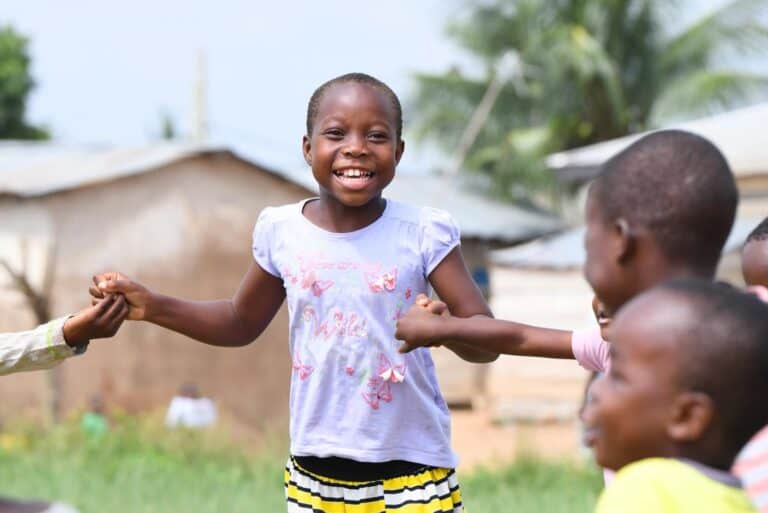Yosua, a 15-year-old student in Lampung province, Indonesia, realized that many of his friends were being forced to drop out of school. Erratic rains due to climate change were causing crops to fail, making it impossible for families to afford school fees.
Together with a group of other adolescents, Yosua presented the concerns and solutions around the drop-out rates to village leaders, who took their proposal into serious consideration. Their proposal? Use village funding to build a storehouse to sell crops in times of low harvest, thereby ensuring families will have income to pay school fees.
“We want to make sure all children can go to school” says Yosua about the motivation behind the adolescents’ involvement in village affairs.
How did Yosua and his friends develop the skills they needed to identify solutions to the drop-out problem and the confidence to present their ideas to the village’s elders – when adolescents had never before been part of village decision-making?
Yosua and his friends accredit their ability to Adolescent Circles, a programme supported by UNICEF which encourages meaningful participation by providing a space for adolescents to learn how to organize, advocate and take action to bring about change in their lives.
What is meaningful participation?
Adolescent participation has a very specific meaning in the context of human rights. Embodied in the Convention on the Rights of the Child (CRC) in Article 12, the notion of participation recognizes the important roles adolescents can place in shaping their lives and emphasizes the obligations on the State to create the conditions necessary to enable adolescents to express views and have them taken seriously.
UNICEF defines meaningful participation as occurring when adolescent girls and boys, either individually or collectively, form and express their views and influence matters that concern them. Participation opportunities and activities must be inclusive, giving adolescents of varying ages, family wealth levels, and physical, emotional and cognitive abilities the chance to take part in decisions that affect their lives.
Yosua and his friends reported boosts to their self-confidence and their ability to affect change through their experience in the village affairs.
After participating in a few Adolescent Circles sessions, I feel much more confident to speak up and believe in myself”, says 15-year-old Elga, Yosua’s friend, “I have learned that the key to good communication is listening and really respecting everyone’s opinion.
Communication is one of many skills needed to meaningfully participate in society. Other skills include problem solving, negotiation and stress management, and the development of self-esteem and empathy.
When adolescents are provided the chance to participate, they also are given the chance to acquire or strengthen skills and improve their sense of self: the more adolescents participate, the more skills they develop, the more they feel able to participate.
Towards an universal measurement of adolescent participation
The measurement of how participation takes place and its impact on adolescents’ lives and improved sense of self is a complex undertaking.
Challenges include the extremely varying contextual nature of an adolescent’s life in terms of the ways in which meaningful participation can occur.
How do we measure, for example, meaningful participation for an adolescent boy from a middle-class family living in a North American city, as well as for an uneducated girl from a poor family living in rural Africa?
The Data & Analytics Section (D&A) and the Adolescent Development and Participation Section (ADAP) of UNICEF are undertaking extensive conceptual and methodological work to develop a new approach to measuring participation. In previous efforts, adolescent participation has typically been measured in terms of the existence of legal structures (such as voting age), social and cultural norms around decision-making, involvement in programmes or activities aimed at fostering skill development, membership in certain groups, or use of online or offline platforms which give adolescents a voice.
The new approach proposed by UNICEF focuses on participation by adolescents in decision making related to important matters that concern them directly and indirectly. The objective is to capture experiences of participation that have a positive impact on adolescent wellbeing, and to measure how participation influences the development of core competencies and soft skills such as self-confidence, motivation, ability to form and express views, negotiation and communication, and the belief in the capacity to bring about change in life.
A conceptual framework on adolescent participation has been finalized and technical consultations have been held to support the development of measurement tools, including indicators and questionnaires for data collection. Testing of the tools in different countries will follow, leading to the creation of a universal measurement instrument capable of capturing participation across cultures and socio-economics contexts.
The questionnaires will be developed to be suitable for use in population-based measurement efforts, including household- and school-based surveys. Once finalized, these measurement tools will allow policy-makers to assess the extent to which adolescents are able to participate in their families, communities and societies, and to measure the impacts of interventions aimed at fostering skills development.



